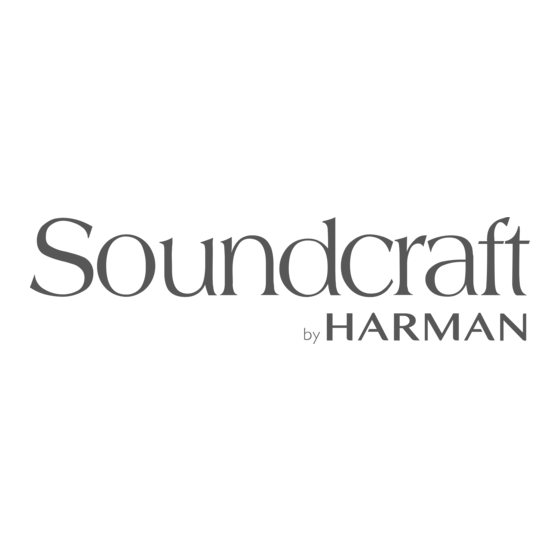
Advertisement
Advertisement
Table of Contents

Summary of Contents for SoundCraft DAKOTA 328
- Page 1 V 2.0 Setup Guide Setup Guide Setup Guide Setup Guide Revised: 04-12-00...
- Page 2 Digital 328 v2 and Frontier Digital 328 v2 and Frontier Digital 328 v2 and Frontier Digital 328 v2 and Frontier Design Group Dakota Setup Guide Design Group Dakota Setup Guide Design Group Dakota Setup Guide Design Group Dakota Setup Guide Contents 1 1 1 1 Connecting The System...
-
Page 3: Connecting The System
Connecting The System Connecting The System Connecting The System Connecting The System Audio Connections Audio Connections Audio Connections Audio Connections Audio connections should be made as shown in the diagram below. Toslink optical cables must be connected both from ADAT Out port A of the Dakota card to the ADAT In port A of the 328 and vice versa, and from ADAT Out port B of the Dakota card to the ADAT In port B of the 328 and vice versa. -
Page 4: Other Connections
Other Connections Other Connections Other Connections Other Connections You may also wish to connect the 328 to the Dakota card via MIDI to allow MIDI automation/System Exclusive dumps from the 328 to be recorded and played back from your PC. If you wish to connect the 328 to the Dakota card via MIDI, the following connections must be made: Either Dakota MIDI port 1 or MIDI port 2 can be used. -
Page 5: Digital 328 Setup
Digital 328 Setup Digital 328 Setup Digital 328 Setup Digital 328 Setup The Dakota card and the 328 (plus any other devices in the studio setup) must have their internal clocks synchronized to allow correct transmission and reception of digital information throughout the system. -
Page 6: S/Pdif Input
Set the desired wordlength on the 328 with the rotary encoder. Press the down cursor to set the port for 328 ADAT port B, as for port A, and again to set the wordlength for port B. Press <ENTER> to confirm the settings. <Tape Ch25->32 >... -
Page 7: Spdif Output
S/PDIF Output S/PDIF Output S/PDIF Output S/PDIF Output On the 328, the stereo S/PDIF output can be sourced from any of the following busses: Mix L/R, Aux 1/2, Aux 3/4, FX1/2 This will usually be set to ‘Mix’, to allow a stereo mixdown to be recorded directly into the Dakota on the playback of a composition. - Page 8 Wordclock & S/PDIF Input Wordclock & S/PDIF Input Wordclock & S/PDIF Input Wordclock & S/PDIF Input The Dakota must be set up to receive the wordclock transmitted by the 328 (via the 328’s S/PDIF output). Open the Dakota Control Panel, accessed by double clicking the Dakota icon on the Windows Taskbar: Click on the ‘Clock/Device Status’...
- Page 9 Firstly, the Dakota clock source must be set to slave its internal clock to the incoming S/PDIF wordclock (outputted from the 328). Set ‘Clock Source’ to Dig In: ‘S/PDIF’: Alternatively, the Dakota will also successfully clock to either ADAT NOTE output of the 328.
- Page 10 You can force Windows applications to only playback at the chosen NOTE samplerate by ticking the ‘Lock’ tick box in the ‘Sample Rate’ section. On the Dakota, the stereo device ‘S 1:2’ (S/PDIF format) can be sourced from any physical input. In this configuration, it must be set to source from the Dakota coaxial S/PDIF input.
- Page 11 Now the validity of the S/PDIF input received by the Dakota must be checked. The ‘Digital Input Status’ section of the ‘Clock/Device Status’ Dakota Control Panel shows the validity of the S/PDIF input with the following 3 indicators: S/PDIF input status indicators (From left to right): Signal Active/Inactive, Digital Audio Format Valid/Invalid, Dakota Locked/Unlocked Firstly, click on ‘Clear Errors’...
- Page 12 S/PDIF Output S/PDIF Output S/PDIF Output S/PDIF Output The stereo output from the Dakota can be set to either AES/EBU or S/PDIF format. In this configuration, this should be set to S/PDIF, so that the 328 correctly interprets the stereo data incoming to the 328’s S/PDIF input.
- Page 13 ASIO Resolution ASIO Resolution ASIO Resolution ASIO Resolution If you wish to use the Dakota as an ASIO device (e.g. with Cubase VST), the playback/record wordlength should also be set. The Dakota supports both 16 bit and 24 bit ASIO wordlength resolution.
- Page 14 MIDI MIDI MIDI MIDI If you wish to use the MIDI interface on the Dakota with the 328, ensure that the MIDI mode is enabled on the Dakota Control Panel. With the System page still open, in the ‘MIDI Mode’ section, select ‘2x2’: MIDI information can now be recorded and played back via the Dakota.
- Page 15 Using The Dakota With The 328 Using The Dakota With The 328 Using The Dakota With The 328 Using The Dakota With The 328 Accessing The Dakota ADAT I/O From The 328 Accessing The Dakota ADAT I/O From The 328 Accessing The Dakota ADAT I/O From The 328 Accessing The Dakota ADAT I/O From The 328 The Dakota will commonly be used with a software sequencer/hard disk recorder to allow the...
- Page 16 Spirit by Soundcraft Harman International Industries Ltd., Cranborne House, Cranborne Road, Potters Bar, Herts EN6 3JN, England. Tel: +44 (0)1707 665000 Fax: +44 (0)1707 665461 http://www.spiritbysoundcraft.com e-mail: spiritsupport@soundcraft.com Dakota Setup Guide...


Need help?
Do you have a question about the DAKOTA 328 and is the answer not in the manual?
Questions and answers